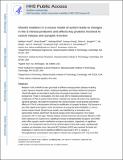| dc.contributor.author | Amal, Haitham | |
| dc.contributor.author | Barak, Boaz | |
| dc.contributor.author | Bhat, Vadiraja | |
| dc.contributor.author | Gong, Guanyu | |
| dc.contributor.author | Joughin, Brian Alan | |
| dc.contributor.author | Wang, Xin | |
| dc.contributor.author | Wishnok, John S. | |
| dc.contributor.author | Feng, Guoping | |
| dc.contributor.author | Tannenbaum, Steven R | |
| dc.date.accessioned | 2020-05-21T20:49:26Z | |
| dc.date.available | 2020-05-21T20:49:26Z | |
| dc.date.issued | 2018-07 | |
| dc.date.submitted | 2018-05 | |
| dc.identifier.issn | 1359-4184 | |
| dc.identifier.issn | 1476-5578 | |
| dc.identifier.uri | https://hdl.handle.net/1721.1/125400 | |
| dc.description.abstract | Mutation in the SHANK3 human gene leads to different neuropsychiatric diseases including Autism Spectrum Disorder (ASD), intellectual disabilities and Phelan-McDermid syndrome. Shank3 disruption in mice leads to dysfunction of synaptic transmission, behavior, and development. Protein S-nitrosylation, the nitric oxide (NO•)-mediated posttranslational modification (PTM) of cysteine thiols (SNO), modulates the activity of proteins that regulate key signaling pathways. We tested the hypothesis that Shank3 mutation would generate downstream effects on PTM of critical proteins that lead to modification of synaptic functions. SNO-proteins in two ASD-related brain regions, cortex and striatum of young and adult InsG3680(+/+) mice (a human mutation-based Shank3 mouse model), were identified by an innovative mass spectrometric method, SNOTRAP. We found changes of the SNO-proteome in the mutant compared to WT in both ages. Pathway analysis showed enrichment of processes affected in ASD. SNO-Calcineurin in mutant led to a significant increase of phosphorylated Synapsin1 and CREB, which affect synaptic vesicle mobilization and gene transcription, respectively. A significant increase of 3-nitrotyrosine was found in the cortical regions of the adult mutant, signaling both oxidative and nitrosative stress. Neuronal NO• Synthase (nNOS) was examined for levels and localization in neurons and no significant difference was found in WT vs. mutant. S-nitrosoglutathione concentrations were higher in mutant mice compared to WT. This is the first study on NO•-related molecular changes and SNO-signaling in the brain of an ASD mouse model that allows the characterization and identification of key proteins, cellular pathways, and neurobiological mechanisms that might be affected in ASD. | en_US |
| dc.description.sponsorship | Army Research Office Institute for Collaborative Biotechnologies (Grant W911NF-09-0001) | en_US |
| dc.language.iso | en | |
| dc.publisher | Springer Science and Business Media LLC | en_US |
| dc.relation.isversionof | http://dx.doi.org/10.1038/s41380-018-0113-6 | en_US |
| dc.rights | Creative Commons Attribution-Noncommercial-Share Alike | en_US |
| dc.rights.uri | http://creativecommons.org/licenses/by-nc-sa/4.0/ | en_US |
| dc.source | PMC | en_US |
| dc.title | Shank3 mutation in a mouse model of autism leads to changes in the S-nitroso-proteome and affects key proteins involved in vesicle release and synaptic function | en_US |
| dc.type | Article | en_US |
| dc.identifier.citation | Amal, Haitham et al. "Shank3 mutation in a mouse model of autism leads to changes in the S-nitroso-proteome and affects key proteins involved in vesicle release and synaptic function." Molecular Psychiatry (July 2018) © 2018 Macmillan Publishers Limited, part of Springer Nature | en_US |
| dc.contributor.department | Massachusetts Institute of Technology. Department of Biological Engineering | en_US |
| dc.contributor.department | McGovern Institute for Brain Research at MIT | en_US |
| dc.contributor.department | Massachusetts Institute of Technology. Department of Chemistry | en_US |
| dc.contributor.department | Koch Institute for Integrative Cancer Research at MIT | en_US |
| dc.relation.journal | Molecular Psychiatry | en_US |
| dc.eprint.version | Author's final manuscript | en_US |
| dc.type.uri | http://purl.org/eprint/type/JournalArticle | en_US |
| eprint.status | http://purl.org/eprint/status/PeerReviewed | en_US |
| dc.date.updated | 2020-01-21T16:23:34Z | |
| dspace.date.submission | 2020-01-21T16:23:36Z | |
| mit.metadata.status | Complete | |

